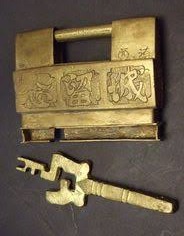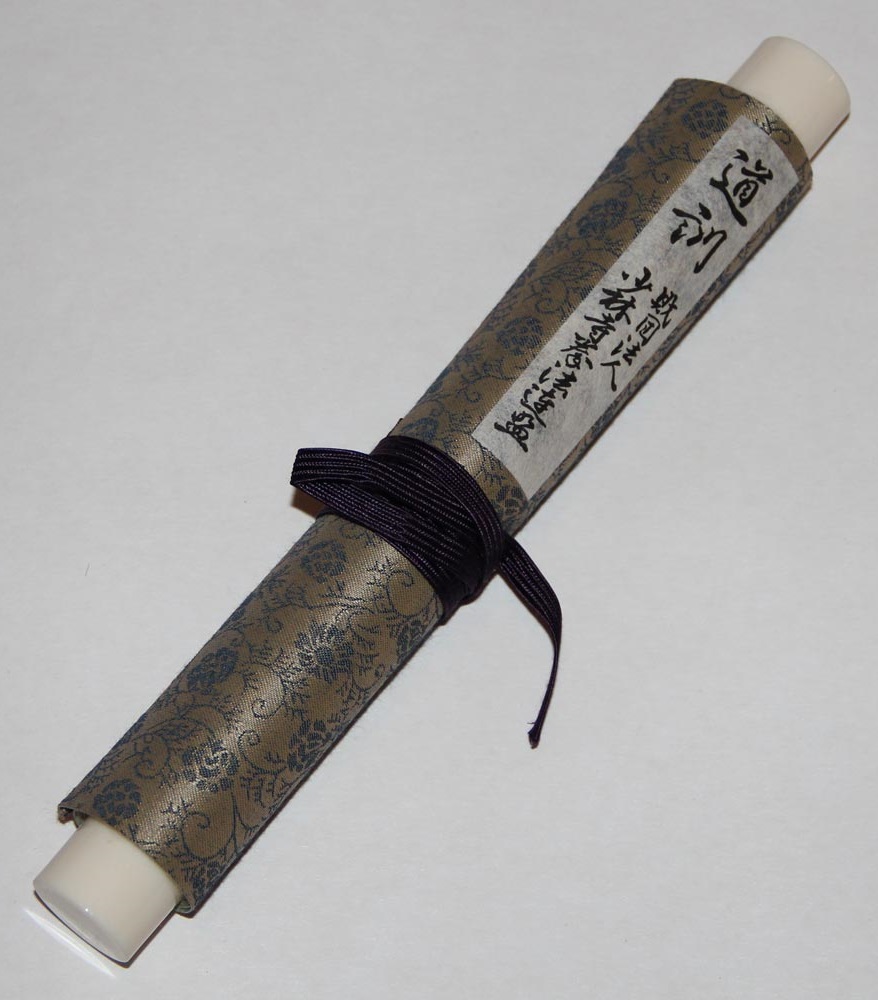
Kesagiri is
usually the second kata or waza taught to
iaijutsu students at the Seishin-Kan. It
contains all five essential components of iaijutsu
technique: (1)
nukitsuke, (2) furikaburi, (3) kirioroshi, (4)
chiburui, and
(5) nōtō, but in markedly different
form than Zenteki-Tō.
Nukitsuke is performed as
kiriage instead of the customary
suihei giri (level cut).
Furikaburi is not overhead, but above and
forward of the right shoulder. And
kesagiri is substituted for
kirioroshi.
These adaptations serve as
examples of the ancient samurai adage,
Ittō sunawachi
bantō ("One sword [meaning
cut]
is 10,000 swords [cuts]"), meaning that all cuts apply
the same principles and differ only in their angle,
target, timing, and distance. Fully mastering one
cut produces mastery of all cuts.
Kesagiri is perhaps the
most technically difficult of the Shitei kata
to perform correctly. Initially, students should
focus their efforts on correct performance of its five
major technical components by performing the kata
slowly and step by step in accordance with the concept
of Dai • Kyō •
Soku • Kei (大 •
強 • 速 • 軽)—meaning Big •
Powerful • Fast •
Light. Begin by focusing on
correctly performing the major (big) motions in their
proper sequence before attempting to add power.
Only after consistly performing the major movements of
the kata correctly, begin increasing the power behind
its movements whilst still performing them slowly.
Next, when your movements are both correct and powerful,
add speed—not by swinging the katana faster, but
by
making all your movements smoother and more flowing.
When you are able to perform the kata correctly with
power in a smooth and continuous sequence, it will seem
effortless (light).
| • |
Nukitsuke |
IMPORTANT
NOTE: We no longer
perform the kiriage
nukitsuke in the manner
shown in the accompanying video,
because it is inconsistent with the fundamentals
of Eishin-Ryū. Instead,
nukitsuke, regardless of the angle of the cut,
follows koiguchi no kirikata with
pushing (not
pulling) the katana from the saya
with sayabiki (pulling the saya
rearward whilst pushing the tuska
forward), smooth, gradual acceleration, and
pushing the
tsukagashira directly
toward the opponents seigan
(between the eyes). Lowering and twisting
the hands into position for kiriage
prior to sayabanare (kissaki exiting the
sayaguchi) not only reveals your
intention to the opponent, but makes it more
difficult to maintain hasuji o tōsu
during kiriage. |
| • |
Furikaburi |
Technically, furikaburi ("swing
overhead") is not performed in kesagiri.
Instead, at the completion of kiriage
(upward cut), the right wrist and forearm turn
180 degrees left, keeping the angle of the
katana in line with the opponent's kesa.
Kesagiri is thus initiated one-handed
and from a position above and to the right of
the right shoulder. |
| • |
Kesagiri |
Begin kesagiri by tightening
the "pinky" finger of the right hand
while stepping forward with the right foot,
using yoriashi to maintain a stable shizentai.
As the katana descends, the left hand
releases the saya and reaches forward
and up to grasp the tsuka an instant
before the monouchi makes contact with
the imaginary opponent. is moving (maai) make the
kissaki travel in the largest circular arc
possible, keep elbows at forehead level until
arms are fully extended at about a 45 degree
forward angle, use tsuka no nigiri kata
to ensure hasuji o tōsu, and
finish the cut with the tsukagashira
pointing at the navel and the top of the
kissaki at the same level as the bottom of
the habaki. |
| • |
Chiburui
(Ō-chiburi) |
To perform chiburui from hassō
no kamae, step back with the left foot
whilst swinging the katana
anticlockwise and releasing the left hand to
secure the saya, as if moving the body
out of the path of the katana. |
| • |
Shoden Nōtō |
Grasp the sayaguchi and form a
koiguchi with the left hand, then—with a
slight forward movement for seme—sweep
the katana laterally across the body,
turning it edge-up and resting the mine
along the lower left forearm with the tusba
just in front of the koiguchi, push the
tsuka toward the right front whilst
pulling the saya rearward and turning
the hips leftward until the kissaki
drops onto the left forefinger, pause to ensure
that the kissaki is in the saya,
then slowly pull the saya forward and
the tsuka rearward so that the
tsuba contacts the koiguchi when
both hands are directly in front of the navel.
Hook the left thumb over the tsuba and
slide the right hand along the tsuka to
the tsukagashira. |
Once Kesagiri can be
performed consistently as described above—with
kiriage, turning the katana 180 degrees rearward
instead of furikaburi, then lunging forward
with kesagiri as three separate steps to
maintain hasuji o tōsu—begin trying
to
combine these three steps into one smooth, continuous
motion. As individual steps, the rhythm is 1-2-3, with
the sword coming to a complete stop on each beat.
But, if the kiriage and turning the sword are combined
into one motion, the rhythm becomes 1-and-2 at first and
eventually 1-2. And after turning the katana as
the completion of kiriage for several hundred
repetitions, the kiriage and kesagiri
can be combined into a single up and down motion on one
beat.
***THE KEY TO MASTERY: don't just practice until
you start getting it right;
practice until you can no longer get
it wrong!
In iaijutsu there are no
named or standardised stances. Instead,
iaijutsu employs a principle called
shizentai. Shizentai
literally means "natural body," which in practical
application should be thought of as the ideal
body structure to support and facilitate whatever
technique is being performed. The correct
kamae for a given movement is determined by its
target, purpose, timing, distance from opponent, power,
and tactical considerations. Shizentai is
only "natural" in the sense that, after years of
diligent training, it becomes instinctive for the
skilled iaidōka—a part of our nature.
In all other respects, shizentai is decidedly
unnatural.
Having made that disclaimer,
there are four stances used in most styles of Japanese
karate-do that provide shoshinsha
(beginners) with useful guidelines for the various forms
of shizentai employed in iaijutsu:
musubi dachi, han-zenkutsu dachi, zenkutsu dachi,
and shiko dachi.
Musubi dachi
("closed stance") is highly similar to the shizentai
used in iaijutsu when standing still or
performing tachi-rei. In musubi dachi the
feet are flat on the floor or ground with the heels
together and the toes of both feet pointed outward at
about a 60 degree angle from each ofther. The body
is erect, but not stiff. The knees are slightly
flexed; not "locked." This kamae
is almost identical to the equivalent shizentai
used in Zenteki Tō at the beginning and end of the
kata,
so it has been used in the description above as a
shorthand
Han-zenkutsu dachi (meaning
"half front [leg] bent stance") is one of the
foundational stances of traditional karate-dō,
and it has several similarities to the shizentai used in
Zenteki Tō for nukitsuke, kirioroshi,
amd nōtō.
Key elements of han-zenkutsu dachi include:
(1) feet at shoulder-width (heel to heel), (2) distance between the
toes of the trailing foot and the heel of the leading
foot is the length of the student's shin, (3) front knee is bent so that the kneecap
is directly above the big toe, (4) rear leg is nearly "locked"
straight, (5) both feet are flat on the floor (neither
heel raised), (6) weight is distributed evenly (50%/50%)
between the front and rear feet, as well and left and
right sides, (7) back is straight
and posture erect, (8) shoulders are aligned with and
directly above the hips, and (9) slight forward pressure
is exerted against the front foot with equal backward
pressure against the rear foot.
Zenkutsu dachi (meaning
"front [leg] bent stance") is identical to
han-zenkutsu dachi in every respect except that
the distance between the
toes of the trailing foot and the heel of the leading
foot is the length of the student's shin plus the length
of one foot. Intermediate and advanced iaidōka
often perform nukitsuke with greater reach and
power than shoshinsha, so their shizentai
during nukitsuke may more
closely resemble zenkutsu dachi.
There is no kamae
in Zenteki Tō similar to shiko dachi,
so it will be described in connection with a kata
or waza to which it applies.
A kata (型) is an
pattern of movements intended for training in the
techniques and movements it contains, together with the
underlying principles that make them effective, but not
necessarily their practical use in combat.
Therefore, when performing this or any iaijutsu kata,
one must not only perform its movements correctly,
but also think about their purpose and how to maximize
their effectiveness. There is no term used in
iaijutsu for this analytical process, but it is
called
bunkai
and
ōyō
in karate-dō. It is
therefore vital to examine each movement in the kata
step-by-step (bunkai) in the context of its
purpose and use (ōyō)
to reverse-engineer how it serves to minimise exposure
to the enemy's attack and simultaneously maximise the
effectiveness of its countermeasures.
Performing bunkai with a
comprehension of
ōyō,
reveals how such principles as maai
(distance control), seme
(maintaining pressure on the opponent),
kamae (structure and posture),
kokyū (breath control), chakugan (eye
contact), kime (concentration
or focus), and zanshin
(awareness of surroundings) are applied to ensure
victory. The thousands of repetitions required to
perfect one's technical performance of a kata
also inculcate the mind with an understanding of its
underlying principles and infuse the spirit with
bushi damashii ("samurai spirit").


 When
learning a new waza (or kata, in
this case), it is important to remind
oneself of the adage: "Manabu no tame ni hyakkkai,
jukuren no tame ni senkai, satori no tame ni manga
okonau" (学ぶのために百回、熟練のために千回、悟りのために万回行う.).
When
learning a new waza (or kata, in
this case), it is important to remind
oneself of the adage: "Manabu no tame ni hyakkkai,
jukuren no tame ni senkai, satori no tame ni manga
okonau" (学ぶのために百回、熟練のために千回、悟りのために万回行う.).
